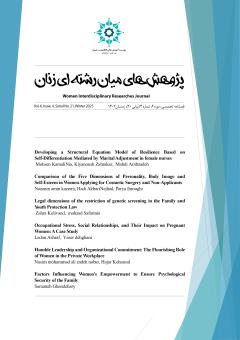Legal dimensions of the restriction of genetic screening in the Family and Youth Protection Law
Subject Areas :Zahra Kolivand 1 , Mahzad Safarinia 2
1 - Master's student, Family Law major, Non-Profit Welfare School, Tehran, Iran.
2 - PhD in International Law, University of Tehran ,Assistant Professor, Faculty of Refah Faculty, Director of Law Department of Refah Faculty
Keywords: Abortion, Screening, Healthy Family, Genetics, Young Population.,
Abstract :
Abstract
Early identification of prenatal diseases and timely treatment of genetic abnormalities are among the main challenges of the healthcare system. In the field of medicine, screening is defined as a strategy for examining the population to identify individuals at risk of a health-threatening condition, with the aim of early detection for intervention or early disease control and its complications. This process is carried out in the form of a series of screening tests in different months of pregnancy. Laws related to genetic screening have existed in our country for decades, whereby couples were financially supported to conduct relevant tests before the birth of their child and during the fetal stage. In the second half of 1400 (Shamsi Calendar), the Law on Family and Youth Protection of the Population was approved by the Parliament, which, pursuant to Articles 53 and 56 of this law, created restrictions on genetic screening, and Article 56 of this law repealed the Medical Abortion Law of 1384 (Shamsi Calendar). Article 53 of this law basically prohibits screening for diseases that lead to the birth of a baby with a difficult-to-treat disease, and in addition, doctors and health workers are not required to recommend screening. As a result, discussions around hardship, elective abortion in cases of abnormalities, and treatments that impose difficulties on families have been restricted. This research aims to examine the need to amend Articles 53 and 56 of the Population Youth and Family Support Plan and address women's challenges in the field of genetics and therapeutic abortion, using a descriptive-analytical method and data collection.
1- قرآن کریم
2- حسین، اسماعیلی(2015). بررسی سقط جنین در صورت به خطر افتادن جان مادر و جنین. مجله علمی-پژوهشی فقه پزشکی، 7(23-22)، 75-106. doi:10.22037/mfj.v7i23-22.10682
3- افشار قوچانی، زهره(2014). نقد و بررسی ماده واحده قانون سقط درمانی مصوب 1384. فقه و حقوق خانواده، 19(60)، 123-144. doi:10.30497/flj.2014.59317
4- آلبویه، علیرضا(2011). حق زن بر کنترل بدن خود. نقد و نظر، 16(62)، 29-60.
5- انجو، سید علی(2022). نگاهی به غربالگری و سقط جنین از منظر اخلاق پزشکی. پژوهش در دین و سلامت، 33(8)، 5-7.
6- آهوران، نوشین(1386). بررسی ادله جواز و حرمت سقط جنین. مجله حوراء، شماره 25.
7- حسینی، مرضیه(1400). خبرگزاری ایرنا. حذف غربالگری مادران باردار و خطر افزایش جمعیت معلولان، کد خبر: 84308302..
8- جباری، مصطفی؛ و صابریان، بهروز(1393). تکفرزندی مصداق سوءاستفاده از حق، مطالعات فقه و حقوق اسلامی، شماره11، ص51-76.
9- روحی، علی(2011). حق سلامت جنین از منظر اخلاق، فقه و حقوق پزشکی. مجله علمی-پژوهشی فقه پزشکی، 3(6-5)، 87-119.
10- ربیعی، صغری؛ و روشن، محمد(1388). سقط جنین: بررسی سقط جنین از منظر پزشکی، حقوقی، فقهی، اخلاقی-فلسفی، روانشناختی و جامعهشناختی، پژوهشکده ابنسینا، تهران.
11- زینالو، مونا(1397). تحلیل اقتصادی غربالگری¬های سندرم داون در برنامه جاری مراقبتهای دوران بارداری در سال ۹۶ و ارائه برنامه پیشنهادی، پایاننامه دکتری تخصصی، دانشکده پزشکی دانشگاه علوم پزشکی تهران.
12- زمانی، رسول(1385). سقط جنین در نگاه حقوق اسلامی. تهران: انتشارات مؤلف.
13- ساعدی، محمد(1392). سقط عمدی جنین، مجله فقه، دفتر تبلیغات اسلامی: قم.
14- شریعتی، محمد(1399). رویههای غربالگری بارداری نیازمند اصلاح است، کد خبر: 46305، سازمان نظام پزشکی.
15- عباسی، محمود؛ رضوانی، سودابه؛ و قاسمی پور، سعیده(2015). شرایط تحقق سقط درمانی در پرتو مطالعه تطبیقی. مجله پزشکی قانونی ایران، 21(2)،107-116.
16- صادقپور، محمدجعفر(1401). ابهام مستمر قوانین در خصوص وظیفه سازمان پزشکی قانونی نسبت به صدور مجوز سقط جنین، دین و قانون، 31، 54-71.
17- عصرایران(1391). در مورد سندرم داون چه میدانید، کد خبر ۲۴۲۸۹۸.
18- فتحی، الهام(1399). پدیدهی سالمندی جمعیت در ایران و آینده. پژوهشکده آمار، تهران.
19- محسنی بندپی، محمدعلی(1400). با حذف غربالگری، تعداد معلولزایی را زیاد میکنیم. تحلیلی خبری عصر ایران، کد خبر:130481، کدخبر: ۹۰۶۹۶۰.
20- مسجدسرائی، حمید؛ موسوی، مهوش؛ و منظّمی، فاطمه(2021). مبانی شرعی و اخلاقی فرزندآوری با وجود نهی پزشکی به دلیل معلولیّت فرزند. مجله علمی پژوهشی حقوق پزشکی، 15(56)، 531-545.
21- میرزاجعفری، فاطمه(1400). فراز و فرودهای غربالگری در قانون جوانی جمعیت. کد خبر 5387458. گروه جامعه، خبرگزاری مهر.
22- آذری، هاجر؛ و بهرامی، لیلا(2020). توسعۀ مفهومی حق بر سلامت زنان و تحلیل آن در سیاستگذاریهای کلان و خرد. زن در توسعه و سیاست، 18(4)، 529-555. doi:10.22059/jwdp.2021.302554.1007829
23- روستائی، مهرانگیز؛ و مقدسی، محمدباقر(2023). ارزیابی سیاستهای جمعیتی در سنجه اصول جرمانگاری. با تأکید بر قانون حمایت از خانواده و جوانی جمعیت. پژوهشهای حقوق جزا و جرمشناسی، 10(20)، 117-150.
doi:10.22034/jclc.2022.328186.1646
24- فلاحی، احمد(2022). بازاندیشیِ شناخت مسئله و راهکار؛ نگاهی انتقادی به رویکرد جرمانگارانه قانون حمایت از خانواده و جوانی جمیعت. سیاستگذاری عمومی، 8(2)، 205-217.doi:10.22059/jppolicy.2022.87955
25- Veenhoven, R. (2011). Happiness: Also known as “life satisfaction” and “subjective well-being”. In Handbook of social indicators and quality of life research (pp. 63-77). Dordrecht: Springer Netherlands.
doi.:10.1007/978-94-007-2421-1_3
26- Akrami, S. M., Parvin, K., & Razmjoo, M. (2021). Legal review of fetal health screening and medical abortion in the population rejuvenation plan and family support. Medical Law Journal, 15(56), 505-516.
27- Biggio Jr, J. R., Morris, T. C., Owen, J., & Stringer, J. S. (2004). An outcomes analysis of five prenatal screening strategies for trisomy 21 in women younger than 35 years. American journal of obstetrics and gynecology, 190(3), 721-729. doi:10.1016/j.ajog.2003.09.028
28- Bringman, J. J. (2014). Invasive prenatal genetic testing: A Catholic healthcare provider's perspective. The Linacre Quarterly, 81(4), 302-313. doi:10.1179/2050854914Y.0000000022
29- Chervenak, F. A., & McCullough, L. B. (2015). Ethical issues in the diagnosis and management of genetic disorders in the fetus. Genetic Disorders and the Fetus: Diagnosis, Prevention, and Treatment, 1106-1130.
doi:10.1002/9781118981559.ch34
30- Gregg, A. R., Gross, S. J., Best, R. G., Monaghan, K. G., Bajaj, K., Skotko, B. G., ... & Watson, M. S. (2013). ACMG statement on noninvasive prenatal screening for fetal aneuploidy. Genetics in medicine, 15(5), 395-398.
doi:10.1038/gim.2013.29


